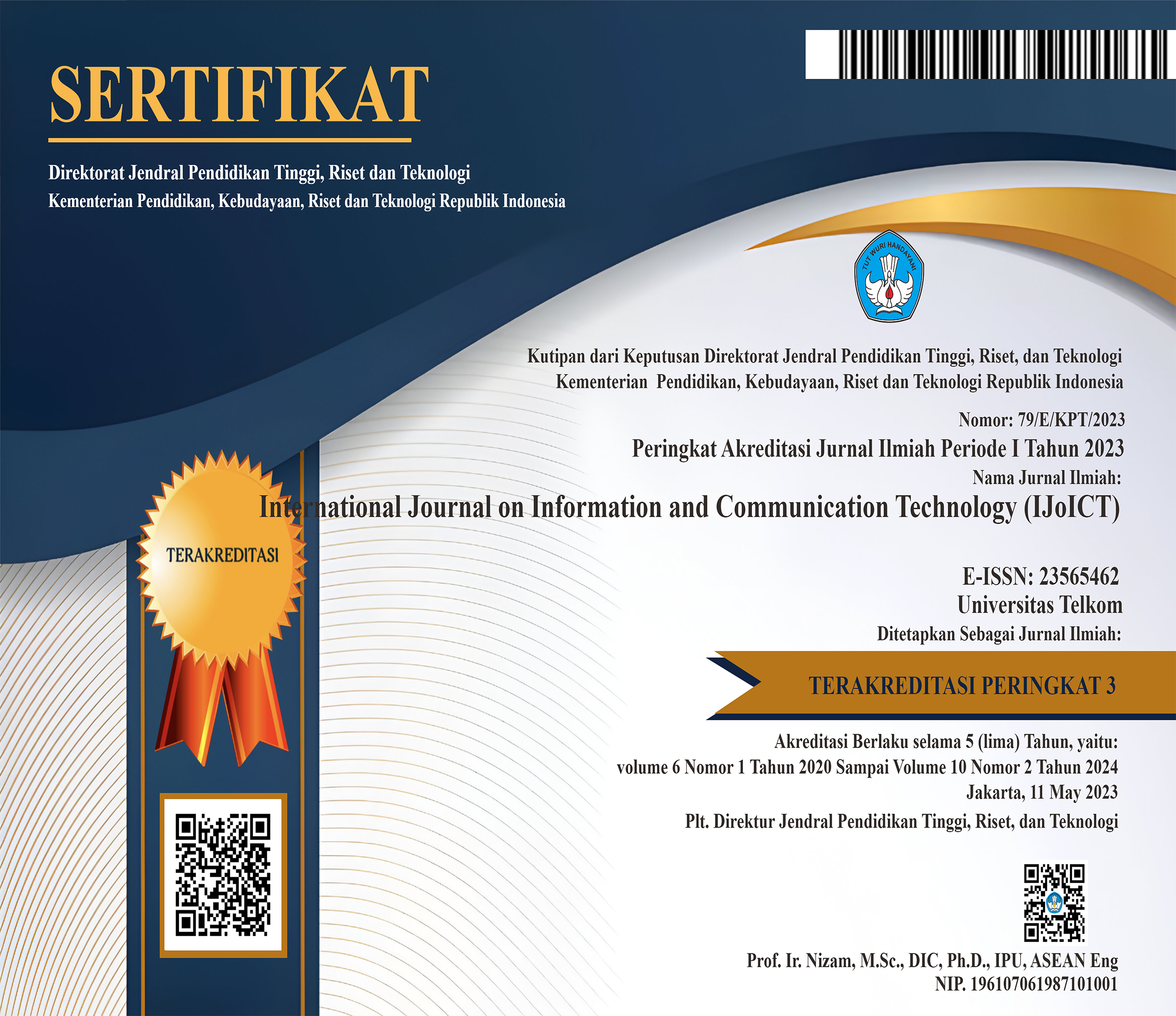Performance Comparison of Several Range-based Techniques for Indoor Localization Based on RSSI
 Abstract views: 320
,
Abstract views: 320
,
 pdf downloads: 212
pdf downloads: 212
Abstract
The classical rang-based technique for position estimation is still reliably used for indoor localization. Trilateration and multilateration, which include three or more references to locate the indoor object, are two common examples. These techniques use at least three intersection-locations of the references' distance and conclude that the intersection is the object's position. However, some challenges have appeared when using a simple power-to-distance parameter, i.e., received signal strength indicator (RSSI). RSSI is known for its fluctuated values when used as the localization parameter. The improvement of classical range-based has been proposed, namely min-max and iRingLA algorithms. These algorithms or methods use the approximation in a bounding-box and rings for min-max and iRingLA, respectively. This paper discusses the comparison performance of min-max and iRingLA with multilateration as the classical method. We found that min-max gives the best performance, and in some positions, iRingLA gives the best accuracy error. Hence, the approximation method can be promising for indoor localization, especially when using a simple and straightforward RSSI parameter.
Downloads
References
[2] S. Choy, J. Handmer, J. Whittaker, Y. Shinohara, T. Hatori, and N. Kohtake, “Application of satellite navigation system for emergency warning and alerting,†Comput. Environ. Urban Syst., vol. 58, pp. 12–18, 2016, doi: 10.1016/j.compenvurbsys.2016.03.003.
[3] H. Jo, S. Kang, H. J. Kwon, and J. D. Lee, “In-door location-based smart factory cloud platform supporting device-to-device self-collaboration,†2017 IEEE Int. Conf. Big Data Smart Comput. BigComp 2017, pp. 348–351, 2017, doi: 10.1109/BIGCOMP.2017.7881691.
[4] R. Mautz, “The challenges of indoor environments and specification on some alternative positioning systems,†Proc. - 6th Work. Positioning, Navig. Commun. WPNC 2009, vol. 2009, pp. 29–36, 2009, doi: 10.1109/WPNC.2009.4907800.
[5] M. Behzad et al., “Design and development of a low cost ubiquitous tracking system,†Procedia Comput. Sci., vol. 34, pp. 220–227, 2014, doi: 10.1016/j.procs.2014.07.014.
[6] G. M. Mendoza-Silva, J. Torres-Sospedra, and J. Huerta, “A meta-review of indoor positioning systems,†Sensors (Switzerland), vol. 19, no. 20, 2019, doi: 10.3390/s19204507.
[7] T. Kim Geok et al., “Review of Indoor Positioning: Radio Wave Technology,†Appl. Sci., vol. 11, no. 1, p. 279, 2020, doi: 10.3390/app11010279.
[8] D. Yan, B. Kang, H. Zhong, and R. Wang, “Research on positioning system based on Zigbee communication,†Proc. 2018 IEEE 3rd Adv. Inf. Technol. Electron. Autom. Control Conf. IAEAC 2018, no. Iaeac, pp. 1027–1030, 2018, doi: 10.1109/IAEAC.2018.8577263.
[9] A. Noertjahyana, I. A. Wijayanto, and J. Andjarwirawan, “Development of mobile indoor positioning system application using android and bluetooth low energy with trilateration method,†Proc. - 2017 Int. Conf. Soft Comput. Intell. Syst. Inf. Technol. Build. Intell. Through IOT Big Data, ICSIIT 2017, vol. 2018-Janua, pp. 185–189, 2017, doi: 10.1109/ICSIIT.2017.64.
[10] H. Park, J. Noh, and S. Cho, “Three-dimensional positioning system using Bluetooth low-energy beacons,†Int. J. Distrib. Sens. Networks, vol. 12, no. 10, 2016, doi: 10.1177/1550147716671720.
[11] M. Scherhäufl, M. Pichler, E. Schimbäck, D. J. Müller, A. Ziroff, and A. Stelzer, “Indoor localization of passive UHF RFID tags based on phase-of-arrival evaluation,†IEEE Trans. Microw. Theory Tech., vol. 61, no. 12, pp. 4724–4729, 2013, doi: 10.1109/TMTT.2013.2287183.
[12] D. J. Suroso, M. Arifin, and P. Cherntanomwong, “Distance-based Indoor Localization using Empirical Path Loss Model and RSSI in Wireless Sensor Networks,†J. Robot. Control, vol. 1, no. 6, pp. 199–207, 2020, doi: 10.18196/jrc.1638.
[13] X. Luo, W. J. O’Brien, and C. L. Julien, “Comparative evaluation of Received Signal-Strength Index (RSSI) based indoor localization techniques for construction jobsites,†Adv. Eng. Informatics, vol. 25, no. 2, pp. 355–363, 2011, doi: 10.1016/j.aei.2010.09.003.
[14] J. Li, L. Pei, M. Cao, and N. Sun, “Super-resolution time of arrival estimation for indoor geolocation based on IEEE 802.11 a/g,†Proc. World Congr. Intell. Control Autom., pp. 6607–6611, 2008, doi: 10.1109/WCICA.2008.4593925.
[15] A. Makki, A. Siddig, M. Saad, J. R. Cavallaro, and C. J. Bleakley, “Indoor Localization Using 802.11 Time Differences of Arrival,†IEEE Trans. Instrum. Meas., vol. 65, no. 3, pp. 614–623, 2016, doi: 10.1109/TIM.2015.2506239.
[16] T. Chuenurajit, D. Suroso, and P. Cherntanomwong, “Implementation of RSSI-Based 3D Indoor Localization using Wireless Sensor Networks Based on ZigBee Standard,†J. Inf. Sci. Technol., vol. 3, no. 2, pp. 1–6, 2012.
[17] S. P. Singh and S. C. Sharma, “Range Free Localization Techniques in Wireless Sensor Networks: A Review,†Procedia Comput. Sci., vol. 57, no. i, pp. 7–16, 2015, doi: 10.1016/j.procs.2015.07.357.
[18] J. Zheng, C. Wu, H. Chu, and Y. Xu, “An improved RSSI measurement in wireless sensor networks,†Procedia Eng., vol. 15, pp. 876–880, 2011, doi: 10.1016/j.proeng.2011.08.162.
[19] S. C. G. Periaswamy, D. R. Thompson, and J. Di, “Fingerprinting RFID tags,†IEEE Trans. Dependable Secur. Comput., vol. 8, no. 6, pp. 938–943, 2011, doi: 10.1109/TDSC.2010.56.
[20] S. Xia, Y. Liu, G. Yuan, M. Zhu, and Z. Wang, “Indoor fingerprint positioning based on Wi-Fi: An overview,†ISPRS Int. J. Geo-Information, vol. 6, no. 5, 2017, doi: 10.3390/ijgi6050135.
[21] R. Dagher, R. Quilez, R. Dagher, R. Quilez, W. Sensor, and N. Nathalie, Localization in Wireless Sensor Networks To cite this version : Localization in Wireless Sensor Networks. 2014.
[22] G. Li, E. Geng, Z. Ye, Y. Xu, J. Lin, and Y. Pang, “Indoor positioning algorithm based on the improved rssi distance model,†Sensors (Switzerland), vol. 18, no. 9, pp. 1–15, 2018, doi: 10.3390/s18092820.
[23] A. Thaljaoui et al., “BLE Localization using RSSI Measurements and iRingLA To cite this version : HAL Id : hal-01387824,†IEEE Int. Conf. Ind. Technol. (ICIT 2015), pp. 2178–2183, 2015.
[24] K. Heurtefeux and F. Valois, “Is RSSI a good choice for localization in wireless sensor network?,†Proc. - Int. Conf. Adv. Inf. Netw. Appl. AINA, no. March, pp. 732–739, 2012, doi: 10.1109/AINA.2012.19.
[25] S. Sadowski and P. Spachos, “RSSI-Based Indoor Localization with the Internet of Things,†IEEE Access, vol. 6, pp. 30149–30161, 2018, doi: 10.1109/ACCESS.2018.2843325.
[26] A. Alshareef et al., “Application of trilateration and Kalman filtering algorithms to track dynamic brain deformation using sonomicrometry,†Biomed. Signal Process. Control, vol. 56, p. 101691, 2020, doi: 10.1016/j.bspc.2019.101691.
[27] M. Carlos-Mancilla, E. López-Mellado, and M. Siller, “Wireless sensor networks formation: Approaches and techniques,†J. Sensors, vol. 2016, 2016, doi: 10.1155/2016/2081902.
[28] D. J. Suroso, P. Cherntanomwong, P. Sooraksa, and J. I. Takada, “Location fingerprint technique using Fuzzy C-Means clustering algorithm for indoor localization,†IEEE Reg. 10 Annu. Int. Conf. Proceedings/TENCON, pp. 88–92, 2011, doi: 10.1109/TENCON.2011.6129069.
[29] P. Cherntanomwong and P. Sooraksa, “Soft-clustering technique for fingerprint-based localization,†Sensors Mater., vol. 30, no. 10, pp. 2221–2233, 2018, doi: 10.18494/SAM.2018.1844.

This work is licensed under a Creative Commons Attribution 4.0 International License.
Manuscript submitted to IJoICT has to be an original work of the author(s), contains no element of plagiarism, and has never been published or is not being considered for publication in other journals. Author(s) shall agree to assign all copyright of published article to IJoICT. Requests related to future re-use and re-publication of major or substantial parts of the article must be consulted with the editors of IJoICT.









.png)

.jpg)




